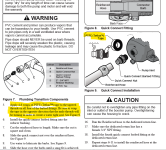I’d like to get some guidance for refitting the suction hose to my booster pump (Polaris PB4SQ). My pressure side cleaner (Polaris 380, I think) has been blowing bubbles and I noticed the concrete is wet under the booster inlet fitting.
I pulled the drain plug, unscrewed the compression collar (correct term?), and pulled the hose. Everything looked and felt solid and clean, so I put on a new light layer of lube and reassembled it. After running the main pump for a while with the booster off, I saw a slow drip, apparently from the threaded fitting that enters the pump housing which I had not touched.

I want to remove/clean/tape/reinstall it, but I’m not sure exactly what materials and methods are required here. I see white on the threads, which I take to be Teflon tape, but I also see some kind of putty. Would someone use plumber’s putty on this? I’m hoping it’s not epoxy putty that someone was trying to use to fix this leak.
So I guess the short question is, do I need anything other than Teflon tape to reinstall this fitting? I have not tried to remove it yet.
I pulled the drain plug, unscrewed the compression collar (correct term?), and pulled the hose. Everything looked and felt solid and clean, so I put on a new light layer of lube and reassembled it. After running the main pump for a while with the booster off, I saw a slow drip, apparently from the threaded fitting that enters the pump housing which I had not touched.

I want to remove/clean/tape/reinstall it, but I’m not sure exactly what materials and methods are required here. I see white on the threads, which I take to be Teflon tape, but I also see some kind of putty. Would someone use plumber’s putty on this? I’m hoping it’s not epoxy putty that someone was trying to use to fix this leak.
So I guess the short question is, do I need anything other than Teflon tape to reinstall this fitting? I have not tried to remove it yet.






![original-20548616-2A90-470E-AF14-9CDE28F420B3[1403].jpeg original-20548616-2A90-470E-AF14-9CDE28F420B3[1403].jpeg](https://www.troublefreepool.com/data/attachments/277/277425-564eaa79aeca9cba3ff6735d8f7a0057.jpg)